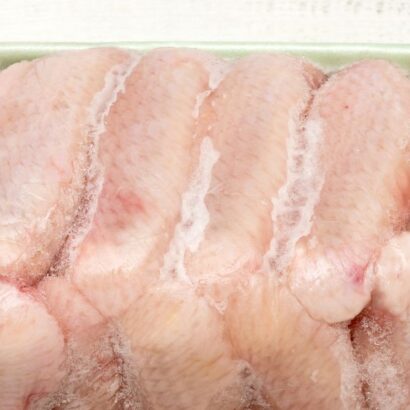An inevitable cooking rite of passage is forgetting to pull your chicken out of the freezer, bringing your dinner plans to an abrupt halt. And depending on the cut of meat you’re working with, defrosting can take what feels like centuries.
There are some circumstances where you can simply toss in frozen chicken and increase the cook time to end up with the same result (if you need some inspo, check out our fave recipes here). But if you’re planning on making a cheesy stuffed chicken dinner or a classic chicken Parm, your bird needs to be fully thawed.
And as if the prolonged defrosting time didn’t throw enough of a wrench into your plans, you also need to consider the food safety concerns. Placing a package of raw chicken in the sun and walking away may seem like the most efficient option, but you also risk Salmonella exposure. Nothing is less appetizing than giving your whole family a foodborne illness.
More From Delish

But before you give up and order takeout, we’re here to help. We chatted with Ellen Steinberg, a Registered Dietician and food safety specialist, to round up the best (and safest) methods to thaw chicken. With just a few precautions, you can get your dinner back on track.
General Food Safety Tips
No matter what method you choose, it’s important to avoid the spread of bacteria. Salmonella is real, y’all—the USDA estimates that roughly 4% of chicken found in American supermarkets is contaminated with the bacteria.
You may think that chicken’s airtight packaging keeps cross-contamination at bay, but that’s not always the case. There may be holes in the plastic or juice left behind from other packages of chicken. It’s especially difficult to spot when the meat is frozen, so Steinberg says it’s better to be safe than sorry.
“You should put your chicken in a roasting pan or a baking sheet so the juices won’t spread,” she says. “And any surfaces that touch the raw meat, like your cutting board or sink, should be disinfected.”
If you want to take food safety even further, Steinberg suggests keeping a separate cutting board in a different color that you use exclusively for raw meat. And for goodness’ sake, wash your hands!
Most Reliable Method: Refrigerator
Thawing chicken in the fridge is one of the most consistent techniques, but it requires a lot of planning. Because refrigerators stay at 40°F and below, frozen chicken can gradually defrost without dipping into the temperature danger zone where bacteria grows.
Because of this, Steinberg says it’s the only USDA-approved method that allows your meat to be refrozen. “If you end up deciding that you don’t want to cook the chicken or you only want to use half of it, you can place it back in the freezer,” she says. There is a caveat, however: Once your chicken’s been thawed for two days, you’ll either need to cook it or toss it.
If you do opt for the refrigerator method, there are some special safety measures to keep in mind. Beyond keeping your meat in a container, you should also place it on the bottom shelf. In the event that your chicken ends up leaking, you want to avoid the juices from dripping onto any foods you’d eat straight out of the fridge.
Steinberg also suggests that you shove the chicken toward the back of your refrigerator. “The temperature is more consistent, unlike the areas closest to the door,” she says.
Fastest Method: Water
If you need to defrost chicken fast, the best way to do it is with cool running water. Unlike the air of the fridge, water conducts heat much more effectively. It’s also key that the water is moving. Just filling up a bowl with water once means the chicken can bring the temperature of the water down and minimize its thawing power.
So if cold water quickly thaws meat, would hot water do the job even faster? Not particularly, no. Cold water is still much warmer than the frozen chicken, so the temperature of your water doesn’t make a major impact on thaw time; however, it does affect the safety.
“If you thaw chicken under warm or hot water, the outside of the meat can enter the temperature danger zone while the center is still frozen,” Steinberg says.
So the ideal way to thaw chicken fast is to place the package in a bowl and run cool water (at 70°F or lower) over it. Depending on the cut of meat you’re working with, your chicken will be ready to use in as little as 15 minutes.
Last Resort: Microwave
The final method approved by the USDA involves using your microwave’s defrost setting. While it’s certainly faster than letting meat thaw in the fridge, we suggest only relying on this method if you have literally no other option.
Steinberg says this technique has the least amount of wiggle room when it comes to planning your dinner. “You have to cook it immediately,” she says. “You can’t defrost it and then decide to cook two hours later.”
While that’s definitely a factor, the main reason we wouldn’t recommend defrosting chicken in the microwave is because it just doesn’t do a particularly good job. The microwave unevenly thaws the meat and usually cooks the outside slightly before the center is even defrosted.
It’s a safe and fast defrosting method—but at what cost? Because of that, we’d only vouch for this technique if your chicken will end up shredded or submerged in lots of sauce.
How do you defrost your chicken? Let us know in the comments.
Editorial Assistant
Gabby Romero is Delish’s editorial assistant, where she writes stories about the latest TikTok trends, develops recipes, and answers any and all of your cooking-related questions. She loves eating spicy food, collecting cookbooks, and adding a mountain of Parmesan to any dish she can.
